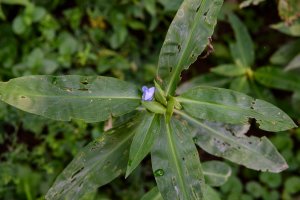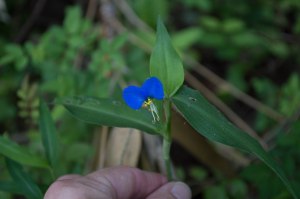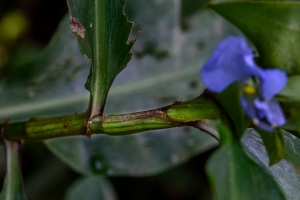 It does seem that the most interesting stuff blooming at this time of year is found in wet places, like along the banks of the Potomac River. Almost all the plants I listed in Wednesday’s post were found within a few feet of the river, including Virginia dayflower.
It does seem that the most interesting stuff blooming at this time of year is found in wet places, like along the banks of the Potomac River. Almost all the plants I listed in Wednesday’s post were found within a few feet of the river, including Virginia dayflower.
Honestly Commelina virginica (Commelinaceae) is not the prettiest of flowers, but I’m always happy to find it, because it’s the native cousin of the more often seen Asiatic dayflower (C. communis). The two upper petals of this alien species are blue, often a more brilliant blue, while the third, lower petal is white.
 Virginia dayflower is a coarse-textured plant with thick stems that stand as much as three feet tall, and thick, long, parallel-veined leaves arranged alternately. Flowers emerge from tight clusters of spathes at the tops of the stems.
Virginia dayflower is a coarse-textured plant with thick stems that stand as much as three feet tall, and thick, long, parallel-veined leaves arranged alternately. Flowers emerge from tight clusters of spathes at the tops of the stems.
As you can see, the flower has three petals, which is typical of the Commelinaceae. Three-petal arrangements are not exactly unusual but they’re not too common, either (five, four, six, and many petals, like in the Asteraceae, are much more common).
Two other native species in the Commelinaceae are found in this area. One is Tradescantia virginiana (spiderwort or spiderlily), pictured below. The other is C. erecta, another dayflower which I’ve never seen; like the alien species shown above it has a white lower petal, but there are other differences used to distinguish between the two species.
Virginia dayflower is found in the mid-Atlantic, the South, the lower Mid-West, and the eastern Great Plains. In Maryland it’s found mostly in the coastal plain. It’s extirpated in Pennsylvania.
Why “dayflower”? As you might suspect, it’s because each flower only lasts a day. According to the USDA Forest Service, the flower opens in the morning and then, rather than closing or fading and falling off, it deliquesces. Which I think is kinda neat. Makes me want to do a time-lapse of one so I can see it happening for myself. 





